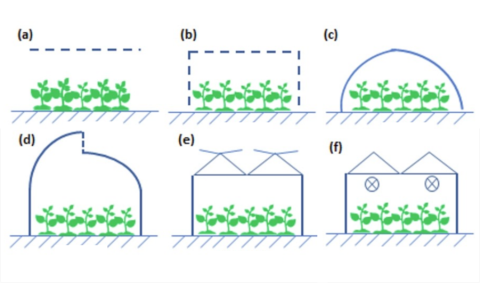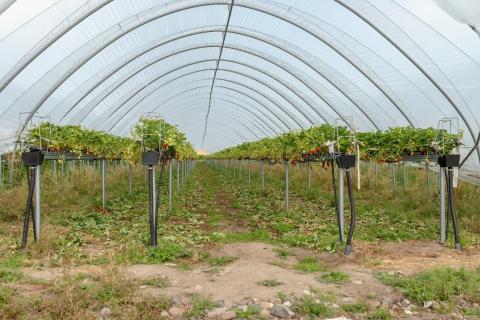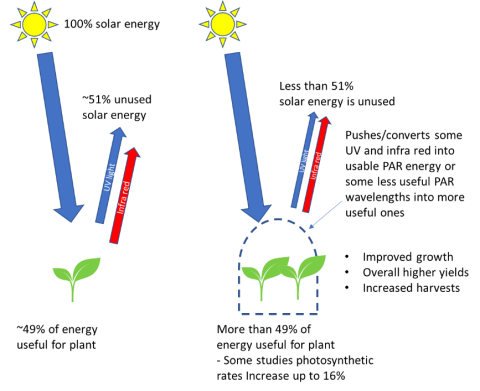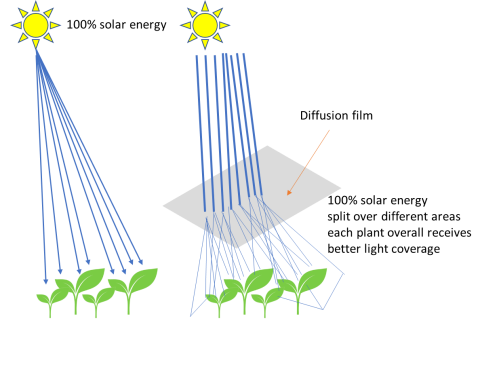23 February 2022
Dr David Cutress: IBERS, Aberystwyth University.
- Crops grown under structural protection can achieve more consistent and often higher yields and quality, as they have fewer environmental impacts to contend with
- Both glass greenhouses and polytunnels incorporate polymer films to moderate the internal microclimate beneficially
- By using films that actively block or change certain wavelengths of light we can impact how crops grow and the yields and quality of the produce achieved
What are they?
The movement towards protected cultivation of crops is one method that can lessen pressures of environmental factors on plant growth, yield and disease impacts by providing agreeable macro and micro-climate environments. This is of increasing interest as climate change leads to more extreme and unpredictable weather effects. Different covered structures can be used depending on the crop, the surrounding climate and predicted benefits. Put most basically, structures fall into the following designs where (a) is a horizontal screen cover roof only; (b) A screenhouse with screened roof and sidewalls; (c) A plastic tunnel; (d) A naturally ventilated greenhouse with a vertical roof opening; (e) A Venlo glasshouse with inclined roof openings; (f) A greenhouse with active climate control.
Adapted from Gruda et al., 2019
Photo selective films are a type of plastic polymer film which can be applied to all of the above-noted structures. They play roles in the production of polytunnels which act as a cheaper alternative to glass greenhouse-based constructions. However, these technologies are equally as viable for greenhouse covers, shades and cladding for more refined growth control in these scenarios too. The photo selective nature of these films refers to their properties that modulate natural light changing either the wavelength that is absorbed, passes through or is reflected by the material. This affects the final intensity and quality of light which passes to the internal environment and therefore is available for a growing crop to use. Plastic polymers for polytunnels are incorporated into growth strategies due to their role in protecting from external climates and other impact factors, as these “sealed” environments facilitate extended growing seasons due to beneficial internal microclimates. Structures such as these act to provide higher temperatures and humidity in cooler seasons allowing overwintering and extended growth of some crops whilst concurrently they can be used in warmer seasons to reduce the amount of light reaching plants (via more opaque plastic) to reduce water loss and prevent UV burn and sun damage. Polytunnels in fields, therefore, tend to lead to increased yields of harvest and longer harvesting periods for important crops, including cucurbits, the benefits of which have already been discussed in a previous article. Whilst small plastic polytunnels are often used personally or in smaller nursery horticultural sectors and market gardens, “Spanish” polytunnels which facilitate the coverage of large land areas saw a rise in presence in the UK from the mid-2000s. There are several varying types of polytunnels such as low ground-level tunnels, largely used for single rows of crops and even the combination of high tunnels with low tunnels nested inside of them.
Why use photo selective films?
Polymer films, in general, can be seen to play important roles in the protection of externally grown produce. This is particularly apparent in the soft fruit sector, where the inclusion of polytunnel protection raised the quantity of UK strawberries achieving class 1 (premium quality) grading from 50% to almost 90% following their increased incorporation. But where do the advantages of photo selective films, in particular, come into play?
First, we should consider that of the light which enters a greenhouse/polytunnel environment, only the spectral region designated the photosynthetic active radiation (PAR) is used in plant photosynthesis, representing 48.7% of the total solar energy reaching the earth. Other regions of the spectrum such as ultraviolet (UV), infrared (IR) and near-infrared (NIR) appear to play other roles in controlling plant growth indirectly. As such manipulation via conversion and reflection of different wavelengths has been investigated. In most plants, the peak maximum photosynthetic regions lie between 455 and 760 nm with blue light (455 to 505 nm) playing roles in initial early plant growth and red light (620 – 760 nm) being more important for general growth following initiation.
Early studies of photo selective films in leafy salad vegetables demonstrated that films that enhanced the far-red spectrum (600 – 800 nm) of light caused increases in dry matter yields and also had impacts on increasing antioxidant capacity in rocket specifically. Furthermore, in an ongoing European Innovation Partnership (EIP) Wales project it is being shown that there are benefits of photo selective films, with properties for increasing diffusion and blocking UV, on leafy salad growth over standard clear films. In a study of fruiting trees, it was found that films impacting the far-red spectrum could increase shoot growth significantly compared to open field trees. These and several other reports suggest that targeted photo selective materials should have benefits not only on yield and productivity but also potentially on producing higher-quality nutrition within produce as plants are effectively able to access more energy.
As well as roles in food crops, photo selective films have been investigated for use in the horticultural sector. Here it has been found that films that absorb or reflect far-red light can be used to delay anthesis (the opening of the flower) and to reduce stem heights for both functional and aesthetic purposes. This ability to impact stem heights could play a key role in adaptations to polytunnel or greenhouse food production scenarios where a reduction in the plant height can enable increased production capacity by essentially allowing more crops to fit in the same space, avoiding competition. In current systems, this is attempted to be achieved by many growers through the use of chemical growth retardants (which have implications on production costs, climate impacts and food contamination) despite research having demonstrated in crops, such as bell peppers, that photo selective films can do just as good a job.
Basic diagram of photo selective film principles
Diffusing light is another area where photo selective films can play an important role as diffused light can penetrate deeper into canopies than direct light leading to improved light distribution within an enclosed environment. This can prevent the impacts of shading and also help the spread of thermal energy (temperature), having an impact on internal microclimate and transpiration pressures applied to plants. Some films give different levels of diffusion (low, medium, high) and consideration of which of these are best can relate to the climate, crop type, planting patterns and season.
Photo selective control of the portion of UV light, in particular, can play important roles in crop production through UV’s interaction with certain plant pests and pathogens. Several studies have noted that UV absorbing films that reduce the passage of UV light have decreased the observation of both insect populations and fungal and other diseases in the internal environment. This suggests that films could play a role in chemical-free holistic integrated pest management (IPM). Furthermore, UV wavelength’s impacts on agricultural plastics and films have some of the biggest degradation effects on their lifespan, as such modifications to stabilise materials against UV can also have impacts on material longevity and benefits overall.
Other innovations
Nanotechnology is seeing increasing roles in its incorporation into agricultural products. This is equally true of photo selective films where nanoparticle incorporation has shown varying impacts. In some instances, the incorporation of the nanoparticles can improve surface morphology, dispersibility, elasticity and thermostability of poly(ethylene terephthalate) (PET) films whilst improving UV blocking and maintaining thermal properties. Other polymer nanocomposites have been investigated on integration into low-density polyethylene (LDPE) for roles in regulating PAR and luminance levels that pass through. It was found that this material which incorporated nanoparticles of titanium oxide (TiO2) was beneficial for blocking a certain proportion of solar energy as well as portions of PAR to facilitate reduced cooling needs during summer periods and was more effective at holding in humidity and diffusing light and temperature than traditional films.
As noted UV-blocking can have beneficial effects on cultivation. Taking this a step further, fluorescent polymers / photoluminescent plastics have been investigated which contain fluorophores (molecules that absorb one type of light and emit a different one) and could absorb UV, essentially having the same effect as blocking it noted above, and actively transform this into light that is emitted back to the plants for use in growth. Such a strategy if designed correctly should provide UV blocking benefits on pests whilst maximising further the functional energy from sunlight. In some trial films, PAR transmission increased by 1 – 3% leading to 11% production increases in strawberries.
One other main disadvantage of plastic films in tunnels and greenhouses can be their hydrophobic nature. For this reason, condensation issues can occur and often surfactants are added to the films to combat this, these, however, have a finite lifespan. Condensation issues can have direct photo selective considerations in that droplets have impacts on reflection of the light passing through to the crops below lowering yields (light transmittance being shown to drop between 5 – 17 %). Drips can also cause direct leaf injury and lead to favourable conditions for the development of many fungal pathogens. Combating this phenomenon involves anti-fogging polymers, innovation is ongoing for such materials as they impact several sectors and some advanced applications include combining anti-fogging properties with properties such as material self-healing and anti-bacterial properties.
Normal vs Anti drip/fog plastic films, image taken from Espi et al., 2006
Other areas where agricultural plastic films are used is in the process of mulching. In the early 1950s low-density polyethylene (LDPE) was used to replace paper where mulching vegetables was performed and this can be seen as the start of the rise of plastic film in agriculture. Plastic use in mulch involves the placement of sheets on soils to suppress weeds, reduce water needs and improve soils. Biodegradable alternatives to traditional plastics have previously been discussed as well as new technologies involving biodegradable polymer sprays. There is also implication to the addition of specific photo selective properties to mulches to add further crop benefits.
Other considerations
Research suggests that photo selective films used either in polytunnel systems or in greenhouse systems should have several beneficial impacts if implemented correctly. So why are these not more commonplace? Whilst an element of this may simply be down to a lack of knowledge and communication of their benefits and that many films are still only in laboratory production scales, there are other areas which require consideration when utilising films for cultivation, these include;
Life span
Life span can be impacted by temperature, UV stability, pesticide chemicals and even the soil makeup which leads to the formation of different volatile reactive oxygen species that can impact the speed at which films degrade near different soils. Finite lifespans lead to implications on environmental impact and cost.
Environmental impact
Due to finite lifespans, agricultural films are required as a repeated input and are part of cyclic addition to waste (unless they are fully biodegradable which a 2017 review noted that little progress in plastics for tunnel cover use incorporating biodegradability had been made). Plastic waste in agriculture is already known to be a considerable issue particularly as plastics in agriculture come into contact with hazardous substances and thus need complex disposal. Environmental impacts of films will include careful consideration of the energy and materials required in their creation, along with their lifespan, their beneficial impacts on crops and a good understanding of their degradation or disposal properties. If films have a good enough benefit over a long enough time on crops these benefits likely negate the negatives associated with production and disposal. Though currently, this information is difficult to find.
Landscape impacts
During the boom in “Spanish polytunnel” use in the 2000s there were heavy protests from the public, particularly in areas of outstanding natural beauty as many considered these structures to ruin the aesthetics of a landscape. Regulations exist surrounding polytunnel use depending on size and location (such as in national parks etc), but these may well change further if public goods provided by naturalistic landscapes are given increasing priority, limiting polytunnel/photo selective film applicability.
Cost
Of course, as with any other inputs in agriculture, an important consideration of films revolves around costs. For films to be readily accepted and utilised the balance of cost to productivity gains must be transparent and well demonstrated, particularly in comparison to standard clear films. If there is not sufficient benefit to the likely higher costs of production of these materials then they will not succeed in a commercial environment unless specific grants and subsidies are employed.
Summary
Protected cultivation is a well-demonstrated way to sustain or improve yields and available growing periods compared to outdoor crop systems. Where protected systems are used there is an available physical structure within which plastic films and photo selective polymer films can be incorporated. The benefits of traditional plastic films alone are well documented but the inclusion of photo selective control of the wavelengths of light and therefore the energy available to plants for photosynthesis and other growth processes seems to add additional benefits. Different photo selective films exist which have shown impacts on yield, types of growth pattern, pest and disease protection and even nutritional values of the end product. If such products can be manufactured cost-effectively, environmentally and be combined with technologies of biodegradable plastic polymers then they could play an important role in improving agricultural sustainability and productivity both in the UK and globally.
If you would like a PDF version of the article, please contact heledd.george@menterabusnes.co.uk





